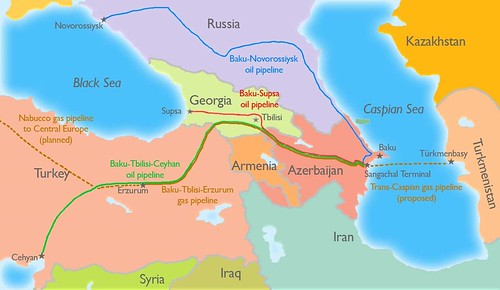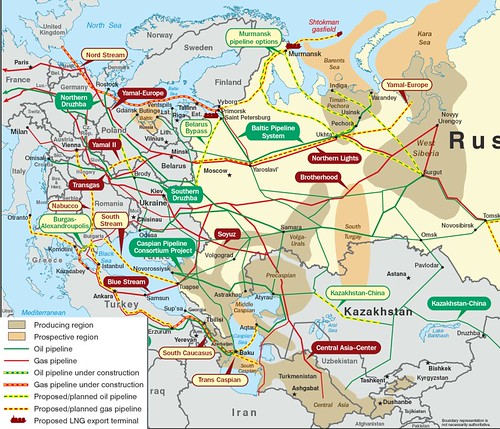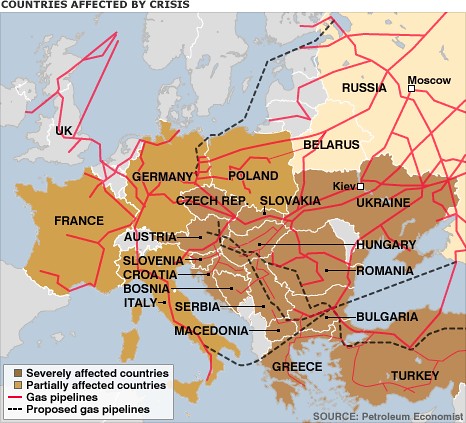Verne wrote about energy resources (coal) in the Arctic & the possibility of human-engineered climate change resulting in enhanced access to these resources. Credits 
The quote in the title comes from "The Purchase of the North Pole". In contrast to fiction, Borgerson contends that U.S. still has to verify the U.N. Law of Sea Convention, improve cooperation with Canada and retrofit its aging icebreaker fleet. According to the USGS, the Arctic likely has 13% of the world's undiscovered oil (90 billion barrels) and 30% of the world's undiscovered gas (1670 trillion cubic feet). Whereas more than 70% of the undiscovered oil resource is estimated to occur in Arctic Alaska, Amerasia Basin, East Greenland Rift Basin, East Barents Basin and West Greenland-East Canada basins, the distribution of natural gas is more concentrated. More than 70% of undiscovered natural gas resources is estimated to occur in West Siberian Basin (Russia), East Barents Basin and Arctic Alaska (USGS factsheet, pdf). The USGS estimated that it would take 37 $/barrel to produce oil from a big (billion barrel) field. Note that the associated natural gas produced is reinjected in these calculations. The WSJ points out that:
[L]arge parts of the Arctic, especially offshore, remain unexplored.
In his article, Borgerson notes:
At the same time, Arctic countries are closely collaborating on mapping the area's seafloor, with scientists from one country frequently sailing on icebreakers of another. On the face of it, everyone seems to be getting along swimmingly.
But all of this camaraderie is at odds with the growing remilitarization of the Arctic. The region is in the midst of transforming from a frozen, sleepy backwater into a potential epicenter of world affairs. How this all plays out in the geopolitical development of the region is a story that is very much still being written.
Arguments in support of various countries' claims to portions of the Arctic can be found here. A map showing various claims in shown below. An interactive version of the map can be found at Spiegel online.

Map of Russian Arctic claims © BBC
Russian developments constitute a major portion of Borgerson's article. He notes that Russia has the largest icebreaker fleet, and that Gazprom is aggressively developing the Shtokman natural gas field, and considering potential future LNG exports to the US eastern seaboard. Interestingly, Borgerson also notes that countries without Arctic coastlines such as China, South Korea, Japan are also participating in Arctic expeditions or are involved in building icebreakers and ice-strengthened tankers.
My opinions:
There are indications that the Arctic likely contains large oil and gas resources. However, the comparatively high cost of crude production in the Arctic indicate that production would not be economical in a market with low crude prices. Additionally, developing the natural gas resource located in the Russian Arctic is likely to involve significant investments in infrastructure, either as liquefied natural gas (LNG)-carrying tankers, or floating production and offloading platforms where the gas is converted on-board to liquid fuels such as methanol. The prospect of refreezing winter seas and rough weather would make operations on oil and gas production platforms a dangerous affair by today's standards. Therefore, I would expect the shipping/tanker companies to be the initial beneficiaries of an ice-free Arctic. Projects such as the Shtokman field would benefit from seasonal ice-free shipping lanes which reduce distances to markets, both in the US as well as South-East Asia/Far East.
Unlike the events in Verne's novel, where the representatives of Britain, Sweden-Norway, Holland, Denmark and Russia agree to form a syndicate against the American-represented North Polar Practical Association, alliances over the ice-free oceans would be tenuous. Recently, Denmark and Canada held talks on the delineation of the limits of the outer continental shelf. The Russian claim over the North Pole would be evaluated by the United Nations Commission on the Limits of the Continental Shelf (CLCS) this May. It is in U.S. interests to ratify the U.N. Convention on the Law of the Sea to have a role in these discussions. Regardless of these outcomes, one fact stands clear; no diplomat or leader can dare to think in similar lines to Jacques Jansen, the Netherlands' representative to the Arctic auction in Jules Verne's novel, who scoffs at the value of the Arctic ocean:
It would be much better to buy a load of codfish than to throw one’s money into the ice-water of the North.






